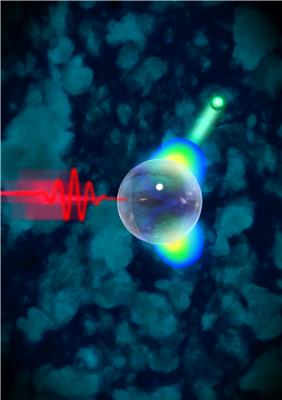Aug 13 2015
A team of physicists and chemists from the Laboratory of Attosecond Physics at the Ludwig-Maximilians-Universität and the Max Planck Institute of Quantum Optics has studied the interaction of light with tiny glass particles.
 Directional electron acceleration on glass nanospheres. A femtosecond laser pulse (coming from the left) hits a glass nanosphere. The light releases electrons (green) from the group of atoms. Graphic: Martin Dulovits, woogieworks
Directional electron acceleration on glass nanospheres. A femtosecond laser pulse (coming from the left) hits a glass nanosphere. The light releases electrons (green) from the group of atoms. Graphic: Martin Dulovits, woogieworks
The relationship between strong laser pulses and glass nanoparticles is a special one – one that could influence medical methods, as scientists from Rostock, Munich, and Berlin have discovered. The interplay between light and matter was studied by a team of physicists and chemists from the Laboratory of Attosecond Physics (LAP) at the Max Planck Institute of Quantum Optics (MPQ) and the Ludwig-Maximilians-Universität Munich (LMU), from the Institute of Physics of the University of Rostock, and from the Freie Universität Berlin. The researchers studied the interaction between strong laser pulses and glass nanoparticles, which consist of multiple millions of atoms. Depending on how many atoms were contained in the nanoparticles, these objects reacted differently over attosecond timescales (an attosecond is a billionth of a billionth of a second). Depending on their size, so called near-fields (electromagnetic fields close to the particle surface) were induced by the laser pulses, resulting in a controlled directional emission of electrons. These findings could eventually extend cancer therapy and imaging methods in medicine. The study was published in the latest issue of the journal Nature Communications.
Strong laser pulses have an extremely pronounced effect on nanoparticles. As soon as the atoms “feel” the electromagnetic wave of the light, their electrons start to oscillate. This produces near-fields at the surface of the particles. These near-fields have dimensions in the nanometer range, and oscillate in a characteristic fashion depending on the wavelength of the incident light.
Led by Prof. Matthias Kling, the LAP-physicists studied silica nanospheres with diameters of 50 to 550 nanometers, which were chemically synthesized by Eckart Rühl’s group at Freie Universität Berlin. The scientists let strong, approximately four-femtosecond-long laser pulses hit the group of atoms (a femtosecond is a millionth of a billionth of a second). As soon as the electromagnetic waves of the light field hit the nanospheres, near-fields formed at the surface and began to pulsate. The larger the light-irradiated spheres were compared to the laser wavelength (720 nanometers), the stronger the effect of the near-fields as an electron catapult.
The researchers observed this effect by using particle detectors to monitor the flight paths of electrons emitted from the near-fields of the nanospheres within the passage of the laser pulse. “The energy and direction of emitted electrons is strongly linked to the spatial and temporal structure of the near-fields. The emission of electrons is like a ping-pong game on the surface of the nanospheres that can be controlled with a precision of attoseconds,” explains Prof. Thomas Fennel from the University of Rostock. He conducted simulations with his team, shedding light on the microscopic processes and their evolution in time. “First, the electrons leave the spheres, but they are then pulled back to their surface. After bouncing off the surface, they obtain a strong, final momentum kick from the near-field, which frees them from the nanoparticles,” Prof. Matthias Kling added.
Since the directional emission of particles can be controlled with this technique using laser light, the researchers argue that a long-term perspective could be medical applications. “With directional electron motion, strongly directed X-rays for imaging applications could be produced,” describes Prof. Eckart Rühl. With sufficiently intense laser pulses, it may also be possible to release ions, which are charged atoms, from the nanocomposite, resulting in strongly directed ion radiation for cancer therapy. Furthermore, the technique might open up new perspectives for material processing beyond the diffraction limit – for instance in order to remove nanometer-sized areas from a surface.
The scientists also believe that the combination of strong light pulses and nanoparticles can become an important building block of future electronics. With so-called light wave electronics, one would be able to compute data at light wave frequency (about 1015 cycles per second): 100,000 times faster than currently possible.